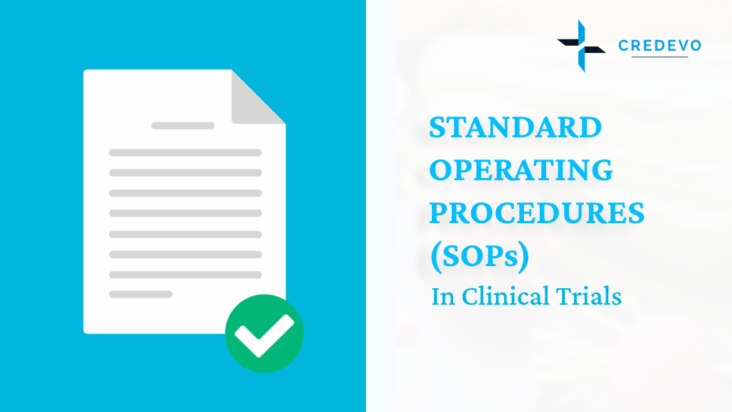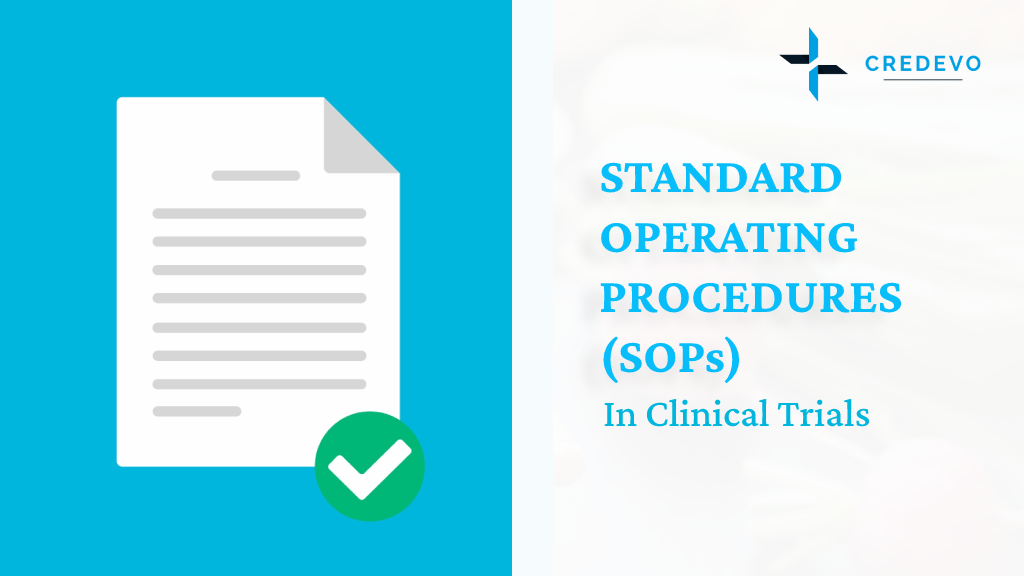Standard Operating Procedures (SOPs) in Clinical Trials

We use Standard Operating Procedures (SOPs) – uniformly written instructions with thorough explanations – to document common tasks, procedures, and organizational practices. SOPs in clinical research serve to define the group’s standard practices. They outline the daily research procedures to ensure that we adhere to institutional, state, and federal guidelines while conducting research tasks.

We should develop SOPs in clinical research. These SOPs need to be sufficiently detailed to maintain uniformity. Their purpose is to guide our research personnel through a specific method, ensuring clarity and comprehensibility. We should give each SOP a clear objective and write it in a style that anyone can understand. The purpose of an SOP is to prevent procedural deviations by outlining prescribed processes that we should follow.
The Importance of SOPs in clinical trials
- They ensure that procedures have been examined and improved to promote operational efficiency.
- Their return on investment is high. SOPs serve as a powerful catalyst for obtaining dependable and high-quality study outcomes. The more consistent your data collection process is, the more confidence you can have in the trial’s findings. No return on investment is higher than this.
- They encourage uniformity and consistency among research team members.
- SOPs prevent noncompliance on a systemic level in a way that a protocol alone cannot.
- SOPs outline the standard procedures for conducting all studies, in contrast to the protocol and associated trial plans.
Looking for a comprehensive site SOP, click here to learn more..
Ten Standard Operating Procedures (SOPs) that enhance the quality of a clinical trial
1. Standard Operating Procedures for protocol training for investigators and study staff
The principal investigator (PI), sub-investigators, and study personnel have a requirement to complete training. This training is specifically for the protection of human subject research participants and the security of personal health information. It must be fulfilled prior to their involvement in any clinical research activities.
Additionally, appropriate study/protocol training is necessary for the Principal Investigator (PI) and every other member of the study team.
It helps to ensure,
- Validity and integrity of study findings
- Protection of study participants’ rights, welfare, and security
2. Investigator responsibilities
The Code of Federal Regulations (CFR) and the Good Clinical Practice (GCP) guidelines specify the duties and obligations of the Principal Investigator (PI) for the conduct and oversight of clinical trials,
- secure the protection of the rights
- protect the health and well-being of study participants
- guarantee the accuracy of the findings
As stated in the FDA regulations, the Principal Investigator of a clinical trial shall adhere to the rules for the protection of human subjects. That includes obtaining informed consent from study participants and ensuring review and approval by the Institutional Review Board (IRB).
3. Delegation of authority
This SOP outlines the process by which the Principal Investigator (PI) grants sub-investigators and other research staff members the authority to carry out clinical study procedures and tasks. It also maintains records of staff and investigator signatures and handwriting samples.
- A Principal Investigator must adhere to the rules governing IC (21 CFR 50) and IRB review and approval (21 CFR 56).
- The investigator should also follow the rules in 21 CFR 312 or 21 CFR 812 if the trial uses an experimental drug or device.
- Additionally, all clinical study investigators should follow the ICH recommendations for good clinical practice.
4. Standard Operating Procedures for study records management
This SOP aims to outline the procedures for compiling and maintaining study records during clinical research.
The investigator and institution must preserve all information in original records of clinical findings, observations, or other clinical research activities essential for the reconstruction and evaluation of the study following FDA laws and GCP recommendations.
The source documentation of research records, including
- the signed informed consent form,
- medical history, medication logs,
- treatment records, protocol assessment results, and
- adverse events,
are combined into subject-specific documents (study participant charts) for each study subject.
5. Documentation and reporting
Departures from the clinical research protocol, good clinical practice (GCP) principles, or applicable federal laws may enhance study participants and compromise the study’s scientific integrity.
It’s a must to address and correct the deviations. Preventative measures must be put in place to ensure they never occur again.
We must report deviations from the standards outlined in this SOP and IRB policies and procedures to the Institutional Review Board (IRB) and support them with GCP documentation standards.
6. Standard Operating Procedures for obtaining written informed consent
Before taking part in a clinical research project, each human subject must voluntarily provide informed consent, which is the responsibility of the Principal Investigator (PI).
The process of obtaining informed consent is ongoing and starts with the initial interaction with a prospective subject and continues throughout their participation. The PI may assign qualified sub-investigators or study staff the duty of conducting informed consent.
To protect human subjects, the principal investigator (PI) or delegate must adhere to the rules outlined in the Department of Health and Human Services Common Rule (45 CFR 46) and the U.S. Food and Drug Administration (FDA) regulations (21 CFR 50), as appropriate.
The International Council on Harmonization (ICH) GCP guidelines, which guarantee that each subject gives free and informed consent before clinical trial participation, should also be followed by clinical trial investigators.
7. Standard Operating Procedures for case report form completion
The case report form (CRF) is a piece of paper, an electronic file, or a collection of files intended to record all the data and outcomes specified by the protocol for each clinical trial participant.
It’s crucial for the CRF that data be entered into it accurately and on time for safety and efficacy and to assure proper trial conduct.
Study teams should adhere to International Council on Harmonization GCP requirements for CRF completion since the data gathered on the CRF serves as the foundation for any trial-related reports or publications.
This SOP’s objective is to set guidelines for the timely and accurate submission of data for clinical trials into the CRF.
8. Investigational new drug application in FDA-regulated research
A complicated set of FDA rules, restrictions, and obligations apply to the conduct of a clinical investigation (also known as a clinical trial) under an IND application that is subject to FDA oversight.
The sponsor of the IND application is in the FDA’s custody and is accountable for ensuring that all rules, commitments, and standards are followed (21 CFR Part 312, Subpart D).
Although pharmaceutical firms are frequently the sponsors of IND applications, the FDA regulations governing IND applications allow the sponsor to act as an individual, a government organization, or an academic institution (21 CFR Part 312.3).
This policy’s goals are to,
- assist in determining when an IND is necessary
- offer assistance and resources to those undertaking clinical trials.
9. Investigational device exemption applications in FDA research
A complicated set of FDA rules, procedures, and obligations apply to the conduct of a clinical investigation (also known as a clinical trial) under an application for an FDA-regulated Investigational Device Exemption (IDE). The FDA holds the IDE’s sponsor in contempt.
The application is in charge of ensuring compliance with all rules, obligations, and requirements. (21 CFR Part 812, Subpart C).
Although pharmaceutical and device corporations are frequently the sponsors of IDE applications, the FDA regulations governing IDE applications allow the sponsor to also be an individual, a government organization, or an academic institution (21 CFR Part 812.3).
This standard operating procedure’s goals are to,
- assist in determining when an IDE is necessary
- offer assistance and resources to those undertaking a clinical trial
- address the procedure for compassionate use (also known as expanded access) and emergency use of an investigational device, which may involve sponsor-investigators in the investigation.
10. Safety assessment and reporting
The evaluation of safety incidents and the accurate reporting of these incidents, which ensure the safety of research participants, are crucial to conducting a clinical trial.
This SOP’s objective is to outline the gathering, assessment, documentation, and requirements for reporting safety occurrences that take place throughout a clinical study, including
- adverse events (AE),
- serious adverse events (SAE),
- unanticipated problems (UP), and
- others.
It’s a must to follow the
- protocol,
- Good Clinical Practice (GCP),
- Institutional Review Board (IRB),
- Food and Drug Administration (FDA), and
- all other applicable laws and regulations when conducting a clinical trial.
The Principal Investigator (PI) is also in charge of safeguarding the rights, safety, and welfare of clinical research study participants.
Click here to learn about protocol writing in Clinical trials
How to create a proper SOP
- At the very least, the SOP should contain the following necessary elements,
- the purpose of the SOP
- definitions of terms and acronyms
- a defined list of responsible parties
- specifics defining the procedures with attachments of examples
- In the SOP, it is crucial to include references to relevant guidelines and rules, such as ICH E6 Good Clinical Practice and 21 CFR 50.
- The Administrator or Director of the organization should sign the SOPs and include the date of approval, indicating that the SOPs are in line with internal regulations.
- Current SOPs should evaluate periodically to see whether the policy applies.
- Review before interactions with sponsors is encouraged and recommended to be done once a year.
- On new departmental SOPs, distribution, education, and training should be uniform.
- It is crucial to record the day research employees received the necessary training and were approved to carry out newly enacted departmental SOPs.
- To maintain compliance, research employees should observe continuously and refresh the training regularly.
Conclusion
The aim of standard operating procedures (SOPs) in clinical research is to assist you and your research department in maintaining compliance with good clinical practices (GCPs), an international standard for conducting studies involving human subjects based on ethics and science.
Keeping SOPs up to date and following them is necessary to get the maximum advantage. Even with the best SOPs in place, they must be adhered to in order to generate accurate and reliable data.
Making and adhering to the SOPs explained in this article will help your site be recognized for its excellence if you are considered for a future study or have plans to grow your research department.
Need our support to create SOPs for your clinical trials?
Do you have any questions or require assistance in creating SOPs for your clinical trials? Please provide your details below, and we will connect with you to discuss our services and support options.